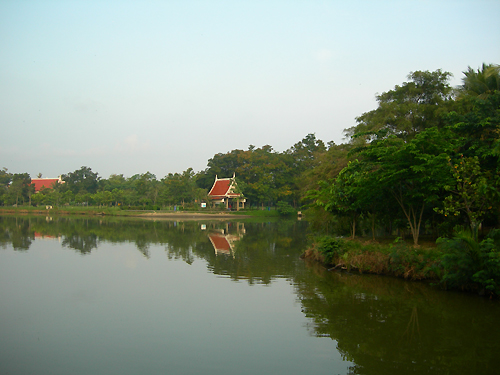On 3rd April 2012 I found myself with the rare opportunity to get out for a morning close to home. Having had great success in finding migrant species in April 2011 at Sri Nakorn Kuan Khan park,
Bangkok, I decided to see if I could get lucky again.
Arriving at about 7am seemed a bit early as my first walk around revealed little other than a Forest Wagtail, a couple of Spangled (Hair-crested) Drongos and the odd Black-naped Oriole. However, a few nice resident birds included Pink-necked Green Pigeon and Stork-billed Kingfisher, both of which are commoner here than anywhere else I know in Thailand, as well as a male Laced Woodpecker.
Sri Nakorn Kuan Khan Park
On previous visits to Bangkok's parks, looking for migrants, I have noticed that most of the best observations seem to occur between 9am and midday, so I made another lap of the park.
Over the next few hours I came across several flocks of small migrant species which included 1 Drongo Cuckoo, 3 Crow-billed Drongos, 1 Lesser Racket-tailed Drongo (quite a surprise to me), 2 Black-winged Cuckooshrikes, 1 Eyebrowed Thrush (1 or 2 others heard passing overhead), 10 Black-naped Orioles, 3 Ashy Minivets and 1 Swinhoe's Minivet.
Also scattered around the unkempt parts of the park (towards the back) I came across a few flycatchers and Phylloscopus warblers which included 5 Radde's Warblers, 2 Pale-legged Leaf Warblers, 1 Arctic Warbler, 2 Yellow-browed Warblers, 3 dauurica Asian Brown Flycatchers, 1 siamensis Asian Brown Flycatcher plus 3 male & 1 female Yellow-rumped Flycatchers.
At around mid morning (10am ish) I spent 20 minutes at the top of the birdwatching observation tower, where I have spotted many interesting birds from before. As well as some common resident species I saw a few more passing migrants; a total of 13 Black Bazas and 2 Japanese Sparrowhawks as well as 2 Dollarbirds.
By midday I was very tired from walking around in the heat and humidity for 5 hours so decided to retreat to the air-conditioning of the car. On the way back I had time to add a Hodgson's Hawk Cuckoo to the list of migrants!
It seems that Sri Nakorn Kuan Khan park is an excellent place to find good numbers of migrating birds in April. I have never managed to get to the park during Autumn migration but I hope to put that right later this year.







